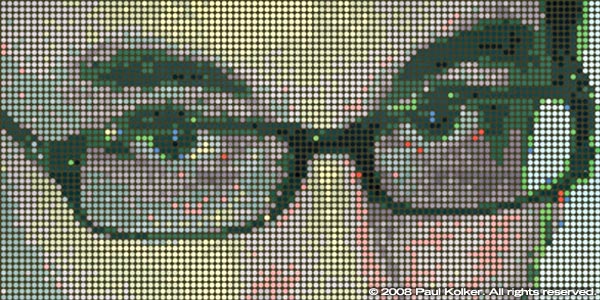How we see things, beyond the neuromolecular physiology of vision, is experiential and based on a learned and historical cerebral archive of prior images. Experience becomes our visual cropping tool, like that of a physician viewing an x-ray. We select, with incredulous bias, what we choose to see and sometimes we enlarge, diminish or fail to see what actually exists.

About faces, too is the sequel to his December 2006 show, about faces, in which Kolker portrayed his stars of science, mathematics, the arts and communication media to create the artist’s popular cultured galaxy of our digital age. Parenthetically, Kolker’s work is founded in this digital age culture of a contemporary divisionism with colored pixels and dots, reminiscent of our view of camera, computer, cell phone and television screens. The subjects of the forthcoming show are Kolker’s artist assistants who are stars of the instant experiment about color, framing and what the artist calls definition or the view up-close and from afar. Up-close we see a minimalist colored dot. From afar we see a highly-defined image.
Even though concept, idea and experimental questions are paramount in Kolker’s work, the process called fracolor has become the artist’s signature. Elemental pigment colors are mixed only with black and/or white but not with each other to form tints and shades, or applied as primary hues. A grid of dots resembling pixels forms the image. A low definition image having about one dot per inch when viewed from afar appears highly defined because we have cropped the central field of vision of Kolker’s canvas of 1089 dots. This same process has been applied to the photographic medium using image fractionation from less than one dot per inch (low definition) to 1089 dots per inch (high definition).
Kolker’s eye to eye, 2008 (inkjet on polyester canvas, 96 × 216 inches, a fracolor in thirty six parts) is a large scale low definition (0.458 dpi) image of artist Jeff Kessel’s framed eyes which follow us, as if in virtual biofeedback, as we change our viewing locus. The image reminds us of our daily eye to eye contacts and that while we frame and focus on the pupillary dots of our subject’s eyes, she in turn frames and focuses on the pupillary dots of our eyes. The dot transcends its color and circular shape and becomes the conceptual “point” of the art.
Paul Kolker: About Faces, too — Opening July 17, 2008.
